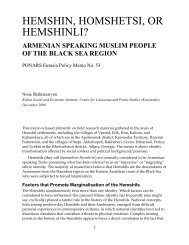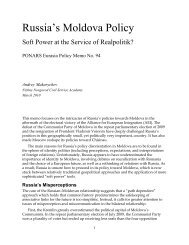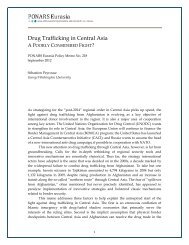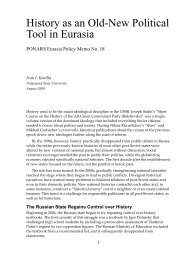View the Policy Memo (PDF) - PONARS Eurasia
View the Policy Memo (PDF) - PONARS Eurasia
View the Policy Memo (PDF) - PONARS Eurasia
Create successful ePaper yourself
Turn your PDF publications into a flip-book with our unique Google optimized e-Paper software.
<strong>the</strong>y published about <strong>the</strong> Prophet Muhammad. Ano<strong>the</strong>r example are suspects of North<br />
Caucasian origin who were among those arrested in relation to terrorist plots in Spain in<br />
August 2012 against British and U.S. targets and in France in February 2013 against<br />
targets in Spain. For <strong>the</strong> most part, however, terrorist cells from <strong>the</strong> region have focused<br />
on Russia, and <strong>the</strong> 2013 Boston attack will not change this basic reality.<br />
Conclusion<br />
The Boston attack needs to be placed in <strong>the</strong> broader context of single-actor jihadist<br />
terrorism in <strong>the</strong> West. While it is clear that <strong>the</strong> Boston Marathon bombing was not an al-<br />
Qaeda operation, once <strong>the</strong> type, scale, and limits of <strong>the</strong> Boston cell’s connections are<br />
better established, <strong>the</strong> suspects may well end up falling under <strong>the</strong> category of a network<br />
agent that engaged in a “jihad of individual terrorism,” a phrase used by global jihad<br />
strategists. Officially, <strong>the</strong> attack is likely to be eventually categorized not as a “lone<br />
wolf”-type incident but as an act perpetrated by a solo cell with some external (domestic<br />
and foreign) connections that acted on its own initiative. More broadly, it is likely to<br />
emerge as a case of internal affiliated terrorism, <strong>the</strong> dominant pattern of homegrown<br />
Islamist terrorism in <strong>the</strong> West. The attack, however, stands out for at least two less<br />
typical features that point in opposite directions and partly contradict each o<strong>the</strong>r. On <strong>the</strong><br />
one hand, it is harder to identify <strong>the</strong> usual mismatch between qualifications and<br />
ambitions in <strong>the</strong> case of this rare successful mass-casualty attack by a jihadist single<br />
actor. This suggests some specialized professional training or outside support. On <strong>the</strong><br />
o<strong>the</strong>r hand, purported links to <strong>the</strong> North Caucasus as a particular regional context are<br />
atypical for U.S.-based jihadist terrorists (of <strong>the</strong> past decade) who plot attacks on <strong>the</strong> U.S.<br />
homeland, even if such links have some precedence among jihadist cells in Europe.<br />
© <strong>PONARS</strong> <strong>Eurasia</strong> 2013. The statements made and views expressed are solely<br />
<strong>the</strong> responsibility of <strong>the</strong> author. <strong>PONARS</strong> <strong>Eurasia</strong> is an international network<br />
of academics that advances new policy approaches to research and security in<br />
Russia and <strong>Eurasia</strong>. <strong>PONARS</strong> <strong>Eurasia</strong> is based at <strong>the</strong> Institute for European,<br />
Russian and <strong>Eurasia</strong>n Studies (IERES) at George Washington University’s<br />
Elliott School of International Affairs. This publication was made possible by<br />
grants from Carnegie Corporation of New York and <strong>the</strong> John D. and Ca<strong>the</strong>rine<br />
T. MacArthur Foundation. www.ponarseurasia.org<br />
8










